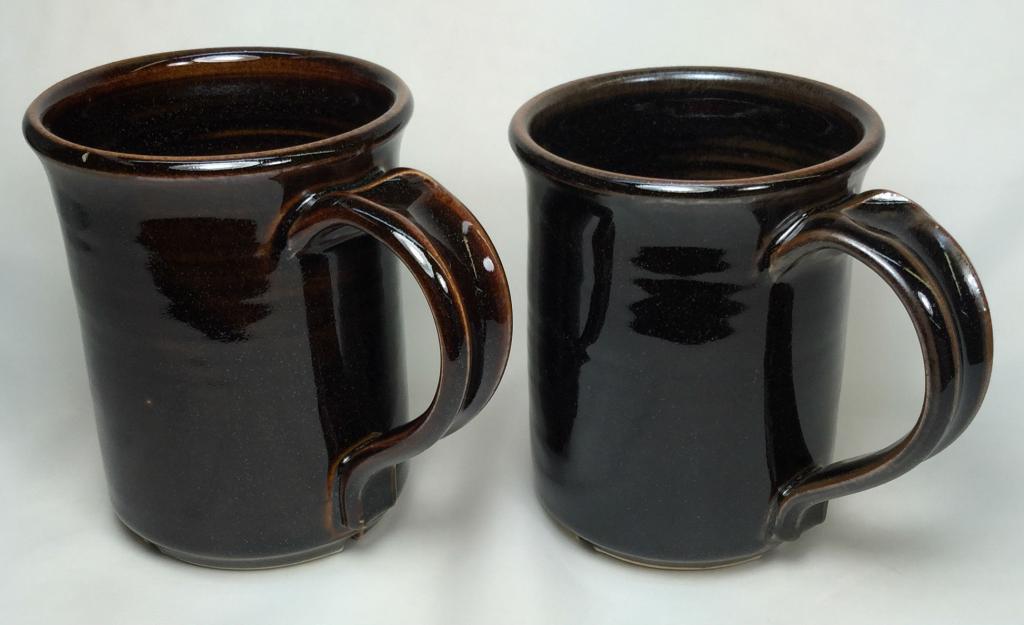| Monthly Tech-Tip |
|
GA10-B - Alberta Slip Tenmoku Cone 10R
Modified: 2022-01-30 15:56:22
You can make a tenmoku from Alberta Slip by adding only 2% iron oxide and 5% calcium carbonate
| Material | Amount |
|---|---|
| Alberta Slip 1000F Roasted | 50.00 |
| Alberta Slip | 50.00 |
| Added | |
| Calcium Carbonate | 5.00 |
| Red Iron Oxide | 2.00 |
| 107.00 | |
Notes
Tenmoku glazes normally contain 10%+ iron oxide, they are extremely messy to use and often have poor slurry suspension properties and are difficult to apply evenly. This recipe is totally different, it is so much cleaner to use. It applies very evenly and suspends well.
You can adjust the drying hardness, drying shrinkage and suspension properties by adjusting the proportion of calcined to raw Alberta Slip (see the preparation page at http://albertaslip.com for more information). You can change the degree of melting by adjusting the calcium carbonate and the intensity of color by tuning the iron oxide.
Related Information
Which tenmoku base is better: Alberta Slip or a clear glaze?

This picture has its own page with more detail, click here to see it.
Right: Alberta slip is almost a Tenmoku glaze by itself at cone 10 reduction. To go all the way only 1-2% more iron is needed (plus a little extra flux for melt fluidity, perhaps 5% calcium carbonate). Compare that to crow-baring a clear glaze into a tenmoku (left): This is G1947U plus 11% red iron oxide. That produces a slurry that is miserable to work with (it stains everything it comes into contact with) and turns into a jelly on standing.
Ravenscrag Tenmoku vs. Alberta Slip Tenmoku on porcelain

This picture has its own page with more detail, click here to see it.
Body is Plainsman P580. Far left: G2894 Ravenscrag Tenmoku with 10% whiting and 10% iron oxide added. Center: Pure Alberta Slip plus 5% whiting and 1% iron oxide. Right: Pure Alberta Slip plus 5% whiting and and 2% iron. The Alberta Slip versions are less messy to use because so much less iron is needed (iron also causes the slurry to gel). The Ravenscrag and higher iron Alberta Slip versions are running, they are too fluid. The rust colored crystals are not developing the way they did with these glazes on an iron stoneware (in the same firing).
Ravenscrag Tenmoku vs. Alberta Slip Tenmoku

This picture has its own page with more detail, click here to see it.
All of these are on a cone 10 reduction fired iron stoneware (Plainsman H443). Far left: G2894 Ravenscrag Tenmoku with 10% whiting and 10% iron oxide added. Center: Pure Alberta Slip plus 5% whiting and 1% iron oxide. Right: Pure Alberta Slip plus 5% whiting and and 2% iron. The Alberta Slip versions are less messy to use because so much less iron is needed (iron also causes the slurry to gel). The Ravenscrag version is running, it is too fluid. Likely 5% calcium carbonate would be enough (and maybe less iron).
Tenmokus made from Alberta Slip and Ravenscrag Slip

This picture has its own page with more detail, click here to see it.
GR10-K1 Cone 10R Ravenscrag Tenmoku (right) compared to Tenmoku made from Alberta Slip (left, it is 91% Alberta Slip with 5% added calcium carbonate and 2% iron oxide). Left is Plainsman P700 porcelain, right is H570. Tenmokus are popular for the way they break to a crystalline light brown on the edges of contours.
Alberta slip vs Alberta Slip tenmoku

This picture has its own page with more detail, click here to see it.
Alberta Slip 100% (left) and Alberta Slip Tenmoku (right). The tenmoku is a little more opaque and forms the characteristic brown crystals on edges of contours (e.g. rim).
Roasting Alberta and Ravenscrag Slips at 1000F: Essential for good glazes

This picture has its own page with more detail, click here to see it.
Roasted Alberta Slip (right) and raw powder (left). These are thin-walled 5 inch cast bowls, each holds about 1 kg. I hold the kiln at 1000F for 30 minutes. Why do this? Because Alberta Slip is a clay, it shrinks on drying (if used raw the GA6-B and similar recipes will crack as they dry and then crawl during firing). Roasting eliminates that. Calcining to 1850F sinters some particles together (creating a gritty material) while roasting to 1000F produces a smooth, fluffy powder. Technically, Alberta Slip losses 3% of its weight on roasting so I should use 3% less than a recipe calls for. But I often just swap them gram-for-gram.
Links
| Firing Schedules |
Plainsman Cone 10R Firing
Six-step oxidize-at-end schedule to 2372F |
| Recipes |
GA10-D - Alberta Slip Black Cone 10R
You can make a black glaze at cone 10R using only 1% black stain in a 100% calcine:raw mix of Alberta Slip |
| Recipes |
L3341B - Alberta Slip Iron Crystal Cone 10R
By adding a little iron to 100% Alberta Slip you can make an iron crystal glaze. |
| Recipes |
GR10-K1 - Ravenscrag Cone 10R Tenmoku
Plainsman Cone 10R Ravenscrag Slip based glaze. It can be found among others at http://ravenscrag.com. |
| Typecodes |
Alberta Slip Glaze Recipes
Alberta Slip is a substitute for Albany Slip that has gained a life of its own so that there are now many glazes based specifically on it. |
| URLs |
http://albertaslip.com
AlbertaSlip.com |
| Glossary |
Tenmoku
Tenmoku is a kind of high temperature reduction firing ceramic glaze. Glossy, very dark brown or maroon, fluxed by iron oxide to have high melt fluidity. |
XML to Paste Into Desktop Insight
<recipes>XML not functional: We are working on this problem.</recipes>
| By Tony Hansen Follow me on        |  |
Got a Question?
Buy me a coffee and we can talk

https://backup.digitalfire.com, All Rights Reserved
Privacy Policy
 Use Plainsman Clays?
Use Plainsman Clays? 